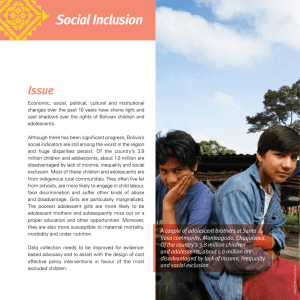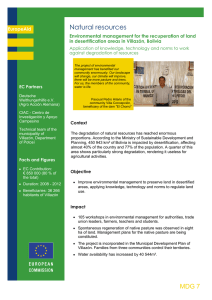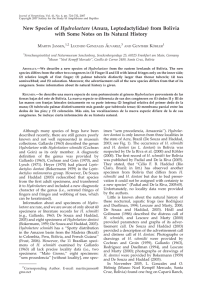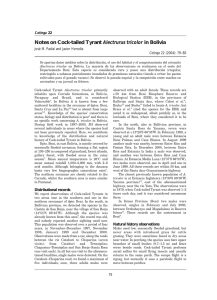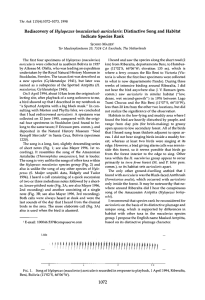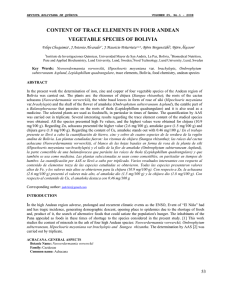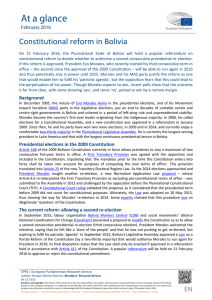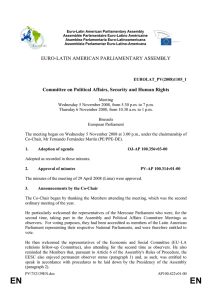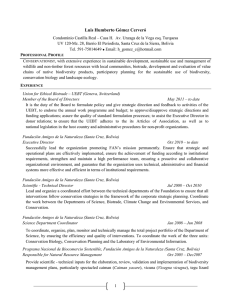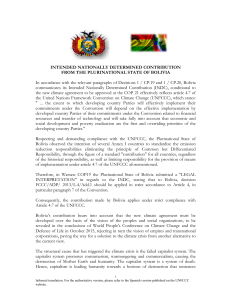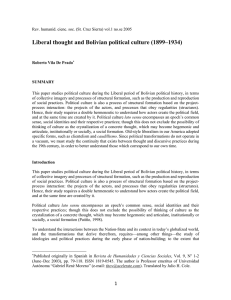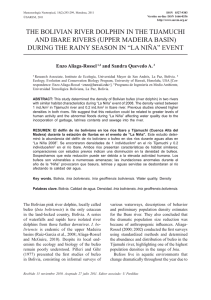Beyond Natural Resource Management Patterns: An Alternative
Anuncio
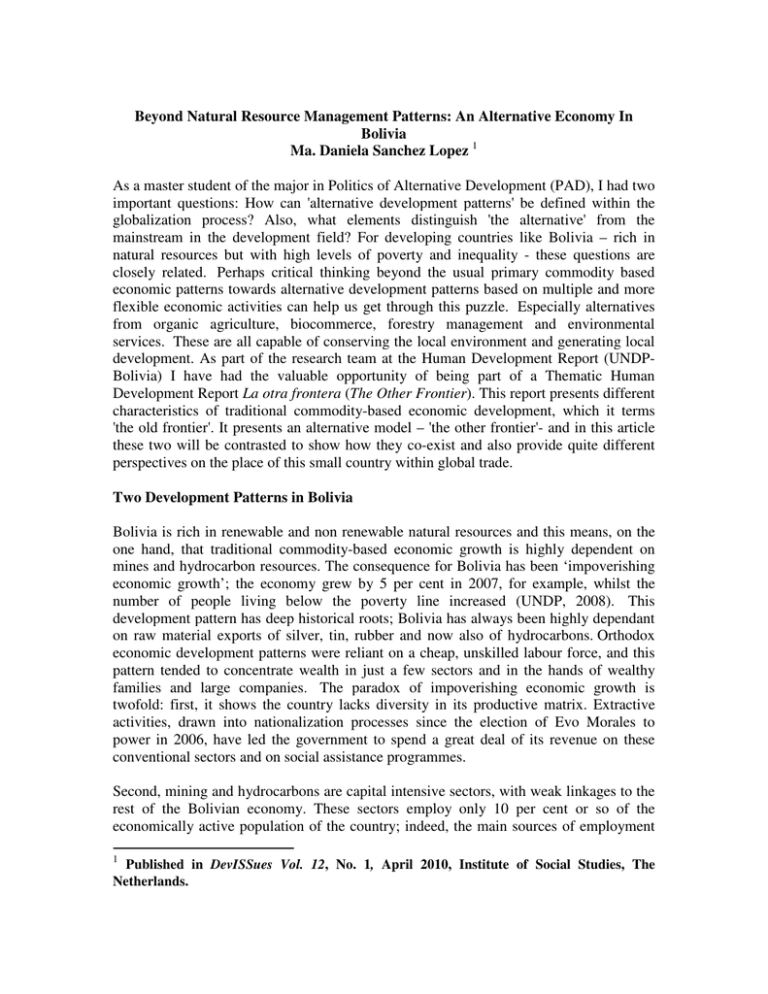
Beyond Natural Resource Management Patterns: An Alternative Economy In Bolivia Ma. Daniela Sanchez Lopez 1 As a master student of the major in Politics of Alternative Development (PAD), I had two important questions: How can 'alternative development patterns' be defined within the globalization process? Also, what elements distinguish 'the alternative' from the mainstream in the development field? For developing countries like Bolivia – rich in natural resources but with high levels of poverty and inequality - these questions are closely related. Perhaps critical thinking beyond the usual primary commodity based economic patterns towards alternative development patterns based on multiple and more flexible economic activities can help us get through this puzzle. Especially alternatives from organic agriculture, biocommerce, forestry management and environmental services. These are all capable of conserving the local environment and generating local development. As part of the research team at the Human Development Report (UNDPBolivia) I have had the valuable opportunity of being part of a Thematic Human Development Report La otra frontera (The Other Frontier). This report presents different characteristics of traditional commodity-based economic development, which it terms 'the old frontier'. It presents an alternative model – 'the other frontier'- and in this article these two will be contrasted to show how they co-exist and also provide quite different perspectives on the place of this small country within global trade. Two Development Patterns in Bolivia Bolivia is rich in renewable and non renewable natural resources and this means, on the one hand, that traditional commodity-based economic growth is highly dependent on mines and hydrocarbon resources. The consequence for Bolivia has been ‘impoverishing economic growth’; the economy grew by 5 per cent in 2007, for example, whilst the number of people living below the poverty line increased (UNDP, 2008). This development pattern has deep historical roots; Bolivia has always been highly dependant on raw material exports of silver, tin, rubber and now also of hydrocarbons. Orthodox economic development patterns were reliant on a cheap, unskilled labour force, and this pattern tended to concentrate wealth in just a few sectors and in the hands of wealthy families and large companies. The paradox of impoverishing economic growth is twofold: first, it shows the country lacks diversity in its productive matrix. Extractive activities, drawn into nationalization processes since the election of Evo Morales to power in 2006, have led the government to spend a great deal of its revenue on these conventional sectors and on social assistance programmes. Second, mining and hydrocarbons are capital intensive sectors, with weak linkages to the rest of the Bolivian economy. These sectors employ only 10 per cent or so of the economically active population of the country; indeed, the main sources of employment 1 Published in DevISSues Vol. 12, No. 1, April 2010, Institute of Social Studies, The Netherlands. remain agriculture (36 per cent) and trade (14 per cent). Consequently, in line with the so-called 'curse of natural resources', the richness of Bolivia's natural resources is not translated into a better standard of life for most Bolivians (Sanchez, 2009). On the other hand, the Report refers to the ‘the other frontier’. This refers to Bolivia's great potential to diversify and re-value the land according to its uses and degree of biodiversity. 'Alternative' activities would include environmental services, ecotourism, sustainable forest management, biotrade and organic agriculture, all being examples of income-generating activities that tend to produce linkages between different sectors of the economy. Such activities also tend to be organizationally sustainable, environmentally compatible and to position the country favourably in relation to the main products involved. This table summarises the issue: Two realities in Bolivia The old frontier: commodity based model The other frontier: intangible added value model Four main commodity exports of Bolivia (hydrocarbons (natural gas), zinc, tin, and soya). World wide they represent: Tiny exports - already visible. For example: • World leader in rainforest certification; • World's top 12 countries with organic agriculture surface (incl. Brazil nut organic plots in the Amazon rainforest); • 0,2% of world hydrocarbons exports; • 1% of world zinc exports; • 3,2 % of world tin exports; • World's top 3 exporter of Brazil nuts; • 0,04% of world soya exports. • World's top 10 exporter of organic coffee and cacao; • World's top 5 exporter of certified rainforest timber. Source: Own translation based on Sanchez (2009) and UNDP (2008) The Potential of an Alternative Development Pattern Although Bolivia's economy will remain hydrocarbon- and mining- based in the long term, the ‘other frontier’ described here has started to be a feasible source of livelihood options for thousands of Bolivians. This ‘alternative’ economy involves an estimated half a million smaller producers and their families, and contributes an estimated US$300 million annually in export revenue, generating 370,000 jobs in total across Bolivia. There are around 60,000 organic producers across Bolivia and 26 organizations involved in Fair Trade networks (which puts Bolivia in fourth place in Latin America). The small size of these initiatives is not an accident; their scale means they are less capital-intensive and so have the potential to diversify both the economy and people's livelihoods. With time, the 'other frontier' might help shape a new identity for Bolivia as a high-ranking, megabiodiversity country. In my view, this alternative development pattern has three main strengths in the Bolivian context: (1) The high-biodiversity and relatively well preserved environment is a distinct source of comparative advantage, opening up prospects for exchanges in alternative markets which value both the quality of the productive process as well as the final product. For instance, organic Brazil nuts, quinoa, organic coffee, vicuña fibre and many other products like these, require good quality and distinctive production processes in order to be certified as organic and have access to these 'alternative' markets. The ‘extra’ price or ‘premium’ paid by consumers in importing countries is because these products are grown and processed without chemicals or pesticides and in ways that are environmentally friendly, without use of child labour and in ways that encourage employment, self-reliance and community development. This alternative pattern of production implies that land use in the long term needs to be sustainable and needs to consider different productive processes not based on simple expansion of the agricultural frontier. Intensification, based on improvement of land use and higher environmental yields and standards, are more important than absolute increases in acreage or production. Different certification processes (organic, fair trade, forestry certifications, among others) are a distinctive and valuable ‘intangible’ value added for all exported commodities in these 'alternative' sectors. (2) The wide, diverse and dense social fabric (tejido social) of small producers in Bolivia represents an important network and creates some positive potentials for public policies. Producers' associations are key actors that can promote local development, can enhance the impact of public interventions and can support capacity building and challenge unequal power relations, especially in terms of access to markets. The 24 successful case studies of the Bolivian UNDP Report show how important the positive impact of peasant and community associations can be to this changed overall economic dynamic. (3) Thirdly, and not least, the imminent threat of the climate change and the stark terms of the environmental debate today are forcing developing countries to find alternatives and ways to insert themselves differently into the global economy. In conclusion, this research experience has convinced me that alternative and sustainable development patterns really are possible. I am also convinced that Bolivia has a unique opportunity and the potential now and in the future, to position itself as an important stakeholder within the new paradigm that involves alternative, more sustainable forms of natural resources use, so that Bolivians can cross 'the other frontier' of development. The responsibility for opinions expressed in this article rests solely with the author. Maria Daniela Sanchez Lopez (PAD 2006) is a researcher at the Human Development Report (UNDP-Bolivia). She has a bachelor's degree in Economic Sciences (Universidad Católica Boliviana, Bolivia, 2003). Her main areas of research include: environment, natural resource management social participation, civil society and economics. She can be contacted at sanchez.danielex@gmail.com /daniela.sanchez@idh.pnud.bo
